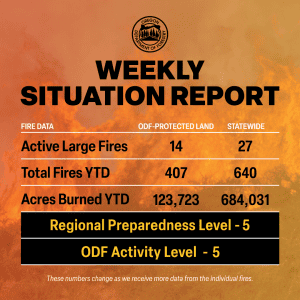(Salem, Ore.) – Starting this past Wednesday, July 17, and into Sunday, July 21, Oregon experienced two separate lightning events that resulted in over 2,000 strikes across the state, which primarily affected Southern, Central and Eastern Oregon. With multiple crews engaged in initial attack on new fire starts and all of Oregon’s available incident management teams on assignment, now is the time for Oregonians to be prepared for wildfires and help prevent future ignitions.
Oregonians are urged to actively practice wildfire prevention, prepare their home and a go-bag for evacuation and know where to sign up for alerts. Add a “Nixle Alert” to your phone, being able to receive instant alerts from emergency services, law enforcement, and the national weather service. Text your zip code to 888777 to receive up to date alerts. Nixle . This is free and “keeps you in the loop” when there’s a crisis and you need current information in your community.
How can people help prevent wildfires?
The Oregon Department of Forestry is urging the public to actively practice wildfire prevention as the state works to control over 20 large fires. Additional human-caused fires on the landscape will draw the firefighting efforts away from the lightning-caused fires and put extra strain on ground and aviation resources, which are already spread thin. YOU can help prevent wildfires by:
- Checking and following your local fire regulations. The majority of the state is either in high or extreme fire danger right now, meaning even the smallest of sparks could start the next large wildfire.
- Remember that debris burning is prohibited statewide.
- Return to check on your burn site if you burned earlier in the year.
- Make sure your car has been recently serviced to avoid faulty parts throwing sparks.
- Don’t drag tow chains.
- Avoid parking vehicles on tall, dry grass.
- Recreate responsibly. Where campfires are allowed, make sure your campfire is DEAD OUT before leaving it by drowning it with water, stirring it with a shovel and repeating that process until it is cold to the touch. If there is heat coming off it, there are still embers that could reignite.
How can I prepare my home to be resilient against fire?
The Oregon State Fire Marshal can help you create defensible space. Defensible space is the area around your home and property that’s maintained to prevent wildfire from spreading. Creating and maintaining defensible space is the best protection you can give your home against wildfire.
A few ideas to protect the first five feet around your home:
- Remove leaves, pine needles, and other debris from the roof, gutters, and on top of and underneath decks.
- Trim tall plants and bushes growing directly under eaves and make sure trees and plants have adequate space from your home and other vegetation.
- Remove dead and combustible plants and mulch; replace it with decorative rock or gravel.
- Cover exterior attic vents, soffit vents, and areas below decks and patios with 1/8″ metal wire mesh.
Be cautious with using power tools and other equipment that can throw sparks and don’t operate machinery in the heat of the day. Summer is a great time to plan defensible space projects to start working on in the fall when wildfire season is over.
How can I prepare myself in case I need to evacuate?
The Oregon Department of Emergency Management (OEM) urges everyone to prepare for wildfires and other emergencies by knowing evacuation levels, staying informed, having a plan, and having a go-kit ready.
Evacuation Levels
- Oregon follows a three-level evacuation notification system, each structured around safety threat level.
- Oregonians should become familiar with “Be Ready, Be Set, Go!” evacuation levels to make informed decisions when receiving evacuation notices.
- OEM urges people to evacuate whenever they feel unsafe, conditions can change rapidly; individuals should always make the best decision for their safety.
- Following an evacuation, people should not return to the area until public safety officials state it is safe.
Stay Informed
- Stay informed sign up to receive evacuation at, gov remember to update information if need be.
- Find the websites for your county emergency management, sheriff’s office, or tribal police and follow them on social media.
- Check your phone settings to ensure wireless emergency alerts are turned on.
Have a Plan
- Do you know what to do during an evacuation? This evacuation checklist explains what to do before, during, and after an evacuation.
- Establish a communication plan with a list of important contacts and a safe place for loved ones to meet if they are separated during an emergency.
- Identify multiple evacuation routes from home, work, or school and plan for transportation needs.
- People with disabilities should consider individual circumstances and specific needs when planning for evacuation, such as special equipment, transportation, and service animals.
- Have an evacuation plan for pets, make a pet evacuation kit in a tote bag or pet crate, and plan for transportation and sheltering of large animals such as horses and other livestock.
Make a Go-Kit
- Assemble an emergency kit of essential supplies that can be grabbed quickly.
- Pack an easy-to-carry backpack or bag for each household member with health and safety items such as food, water, medication, flashlights, phone chargers, clothing, and important documents. Visit American Red Cross to learn more.
Find more information and resources at Wildfire.Oregon.gov.
Recreate Responsibly
Oregon Parks and Recreation Department (OPRD) encourages visitors to know before they go when it comes to campfire restrictions. Due to the continued low humidity and risk of wildfires, OPRD banned campfires at all Oregon State Parks east of the Cascades as well as at parks in high-risk areas around the state until conditions improve. Most Oregon State Parks currently have a campfire ban. Please check park webpages or the wildfire feature story at stateparks.oregon.gov/ before your next visit. Thank you for helping to reduce the risk of wildfires.
 OREGON DEPT. OF FORESTRY – Last week’s highlights
OREGON DEPT. OF FORESTRY – Last week’s highlights
ODF incident management teams:
- Team 1 is in command of the Boneyard Fire near Monument (ODF Central Oregon District). Updates available on the incident’s Facebook page.
- Team 3 is in command of the Battle Mountain Complex near Ukiah (ODF Northeast Oregon District). The Oregon State Fire Marshal has ordered a conflagration. Updates available on the incident’s Facebook page.
- Team 2 is currently on mandatory rest after demobilizing from the Larch Creek fire.
ODF Priority Fires:
- Battle Mountain Complex near Ukiah (estimated 42,474 ac. Combined)
- Includes the Snake (13,557 ac.), NF Owens (3,887 ac.), and Monkey Creek Fire (25,030 ac.)
- Cottage Grove Complex in the South Cascade District (emerging incident, acreage undetermined)
- Boneyard Fire near Monument (14,602 ac.)
- Lone Rock Fire near Condon (116,563 ac)
- Durkee Fire near Durkee (173,758 ac.)
- Whiskey Creek Fire in the Central Oregon District (165 ac.)
- Falls Fire near Burns (120,919 ac.)
- Cougar Creek in Washington near the Northeast Oregon border (8,271 ac.)
After two significant lightning events that started Wednesday (July 17, 2024) evening of last week and ended Sunday, July 21, 2024, the state saw multiple new fire starts primarily across Southern, Central and Eastern Oregon. Due to conditions, especially in Central and Eastern Oregon, a good number of these ignitions experienced high fire activity from the beginning and grew exponentially within a 12–24 hour period.
Over the last week, there have been 2190 lightning strikes across the state, with 632 lightning strikes within the last 24 hours. A weather alert for dry lightning remains in effect through Tuesday, July 23.
However, even in all the chaos, there are successes within the Oregon Department of Forestry.
- ODF IMT 2 demobilized from the Larch Creek Fire near Dufur and transferred command to a local IMT 3, leaving the fire in a good place for the new team to finish it off. The Larch Creek Fire shows how state and local organizations can succeed when they work together to protect communities and natural resources.
- In just five hours from midnight to 5 a.m. yesterday (Sunday) ODF’s Western Lane District received 56 lightning strikes. Anticipating the storm, ODF had staff out early searching for strikes. Along with landowner partners, district firefighters were able to limit the number of fires to six, the largest being four acres. All six fires are now in the mop up phase.
- In the Southwest Oregon District, Firefighters worked overnight Wednesday, July 17, on numerous small fires along the lower Rogue River in Josephine County, making good progress on most incidents and extinguishing others completely. Following the first round of thunderstorms, 10 fires were reported on the steep terrain northwest of Rand and Galice. Resources from ODF, Bureau of Land Management and U.S. Forest Service Rogue River-Siskiyou National Forest immediately responded. As a result, all fires were caught or held at an acre or less.
After the second round of thunderstorms over the weekend, firefighters worked all day on four new lightning-caused fires across the Oregon Department of Forestry Southwest Oregon District, and as of 6 p.m. Sunday, all fires are 100% lined and in various stages of mop up.
What to expect this week
Weather: Low pressure centered off the British Columbia. coast will start nudging across the Pacific NW today. Afternoon/evening thunderstorms will be focused more over eastern Oregon plus eastern Washington near the Canadian border. A deepening marine layer will start spilling over the Cascade east slopes and gaps today potentially bringing very gusty wind to new and existing fires. Conditions somewhat ease Tuesday, but general winds ramp up Wednesday on the eastside. Instability and thunderstorms become pushed south and east as the upper low moves from British Columbia. into Alberta. Some thunderstorms may clip far southeast Oregon Thursday, but the overall trend will be for temperatures and humidity returning closer to normal.
Prevention: With resources strained and limited, NOW more than ever we need Oregonians to prevent human-caused fires and not bring fire hazards onto the landscape. By having less human-caused fires, our resources can focus on detecting, assessing and suppressing new lightning-caused fires that will be popping up in the next several days.
Please, know the fire danger level of the areas where you live, work and play, and follow all local restrictions on burning, equipment use, campfires and other activities that can start wildfires. Find danger levels and restrictions across the state here.
Resources
- ODF wildfire blog and Public Fire Restrictions/Danger Levels map
- Regional situation report and national situation report
- Inciweb (information, photos, videos, and maps from specific incidents)


